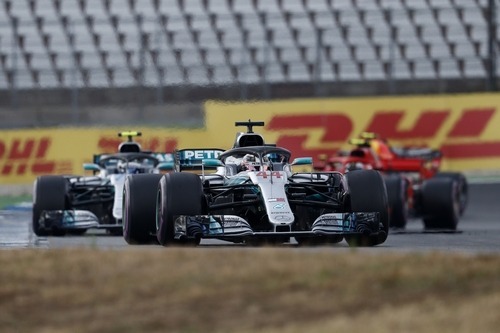
As expected by many fans, Lewis Hamilton was called to the stewards after the race to discuss him cutting the pit exit under the safety car. Hamilton was not penalized, which upset many fans who immediately compared the situation to a similar infraction by Kimi Räikkönen back in 2016. But there are some differences.

The incident in question involved some pit confusion from Mercedes. Under the safety car, Mercedes called Hamilton into the pit lane but told him to stay out, due to Bottas’ pitstop error. Since Hamilton had already passed the pit entry line, he needed to cut through the grass to rejoin the track. This is a violation of appendix L chapter 4 article 4 item D of the FIA International Sporting Code, which reads:
“Except in cases of force majeure (accepted as such by the stewards), the crossing, in any direction, of the line separating the pit entry and the track by a car entering the pit lane is prohibited.”
Kimi Räikkönen was penalized under the same regulation back in 2016 at the European Grand Prix in Azerbaijan while chasing down the Red Bull of Daniel Ricciardo. He received a five second time penalty during the race, which did not impact his race result.
While the situations seem nearly identical, there are some differences between the two incidents, which helps justify the stewards’ decision not to apply a penalty to Hamilton.
The main difference is that, Hamilton’s infraction was committed under the safety car, which means that the other drivers on the circuit are travelling at a relatively slow speed. The stewards deemed that he was not a danger to the other drivers. Kimi Räikkönen committed his infraction while slipstreaming with another car at the fastest point on the circuit. This put him at risk of colliding with another car by rejoining the track or ramming into the rear of the Red Bull as the car slowed to make the pit entry.
Another factor that allowed Hamilton to escape penalty was the wording “force majeure” in the regulation. This broad term simply means any unforeseeable circumstance, provided that it can be justified to the stewards. This is primarily intended to protect drivers from penalties in the event that they suffer a tyre puncture or if there is a collision in the pit entry or if they simply run wide or something along those lines.
However, in this situation, a pit communication error qualifies as a “force majeure” and the Mercedes team were able to successfully plead their case to the stewards. This is different from Räikkönen’s situation in 2016 because the team was not able to offer any justification for committing the infraction. Since no justification was submitted to the stewards, the “force majeure” term does not apply in that circumstance and the stewards are forced to apply a penalty under the regulation.
I think that a five second time penalty was warranted in this circumstance. Even though the violation occurred under relatively harmless safety car conditions, I think that cutting across the grass to rejoin the track is far more dangerous than simply crossing the pit entry line. I can certainly understand Hamilton’s reason for violating the rules, but I think that a penalty should have been applied regardless, in the interest of fairness.
What do you think? Complete the poll below and comment on this article.
The views and opinions expressed in this article are solely those of the author and do not necessarily reflect the official policy or position of any other agency, organization, employer or company. Assumptions made in any analysis contained within this article are not reflective of the position of any entity other than the author.